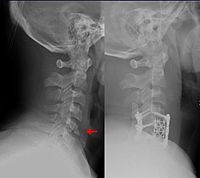
Photo from wikipedia
Background: Skeletal trauma is a primary tenet of pediatric orthopaedics. Many high-quality studies have been published over the last few years with substantial relevance to the clinical practice of pediatric… Click to show full abstract
Background: Skeletal trauma is a primary tenet of pediatric orthopaedics. Many high-quality studies have been published over the last few years with substantial relevance to the clinical practice of pediatric orthopaedic trauma. Because of the volume of literature on the subject, this review excludes upper extremity trauma and focuses on the publications affecting the lower extremity. Methods: An electronic search of the PubMed database was performed utilizing keywords for pediatric lower extremity trauma: pelvic injuries, femur fractures, tibial shaft fractures, femur fractures, ankle fractures, and foot fractures. All 835 papers related to the treatment of pediatric orthopaedic trauma of the lower extremity published from January 1, 2012 to July 31, 2017 were reviewed, yielding 25 papers that were believed to contribute significant findings to the profession. Results: Of the 25 papers selected for presentation within this review, 8 related to tibial shaft injuries, 6 involved the pelvis, 5 involved femur fractures, 4 related to ankle injuries, 2 involved foot injuries, and 1 regarding trauma and venous thromoembolism. The level of evidence for these studies were either level III or IV. Conclusions: Higher-grade pediatric pelvic fractures do not correlate with increased severity of splenic or hepatic injuries. Successful union of femur fractures in older children can be obtained by surgeon preferred method of surgical management. Pediatric tibia shaft fractures should be managed conservatively in most cases; however, fractures with >20% of displacement and associated fibula fractures have a 40% risk of requiring delayed surgical stabilization. Vigilance remains the sin qua non regarding identification and appropriate management of compartment syndrome and venous thromboemobolism in children. Many Salter-Harris I distal fibula fractures are now believed to be ligamentous injury and can be treated as such. Calcaneous fractures remain uncommon in pediatrics, but minimally invasive approaches of surgical reduction and fixation may reduce complications in management. Level of Evidence: Level IV.
Journal Title: Journal of Pediatric Orthopaedics
Year Published: 2018
Link to full text (if available)
Share on Social Media: Sign Up to like & get
recommendations!